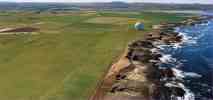|
Dounreay Archive News Index
28 December 04
MONITORING OF SANDSIDE BEACH
UKAEA has instructed its contractor, RWE Nukem, to resume monitoring
of Sandside Beach for radioactive particles. It follows notification from the land-owner
that agreement to access the beach, which was terminated by the land-owner
with effect from April 30, 2004, has been reinstated. Vehicular monitoring resumed
from Thursday, 23 December 2004 in accordance with criteria laid down by the
Scottish Environment Protection Agency.
STAN STANDS DOWN
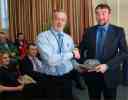 Stan
Fraser, the popular foreman in D2001, retired from UKAEA at the end of
November. Stan, a native of Wick and a joiner to trade, had two stints at
Dounreay, firstly in 1969 when he joined UKAEA Constabulary from the RAF.
Four years later he returned to his original trade, rejoining UKAEA in
1981. He was posted to D2001 and remained there until he retired. At a
presentation ceremony, Dick Stewart, head of process plants
decommissioning, spoke warmly of Stan’s commitment and energy, and the
support he always gave to his staff. Stan
Fraser, the popular foreman in D2001, retired from UKAEA at the end of
November. Stan, a native of Wick and a joiner to trade, had two stints at
Dounreay, firstly in 1969 when he joined UKAEA Constabulary from the RAF.
Four years later he returned to his original trade, rejoining UKAEA in
1981. He was posted to D2001 and remained there until he retired. At a
presentation ceremony, Dick Stewart, head of process plants
decommissioning, spoke warmly of Stan’s commitment and energy, and the
support he always gave to his staff.
Wick High School
Pupils Get First Hand View Of Dounreay
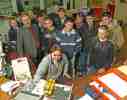 17
senior Wick High School pupils studying National Certificate modules in
electronics and 2 teachers recently made a visit to Dounreay to give them
an insight into how electronics is dealt with in the real world. The group
were advised that decommissioning a site such as Dounreay is not just
simply demolishing buildings, lots of highly technical installation and
maintenance is still required. The group were welcomed to site by Norman
Harrison, Dounreay Director followed by a tour of the site and tours of
the instrument workshop, which allowed them to see actual electronic
equipment on the bench for maintenance and repair, and WRACS (Waste
Receipt Assay Characterisation and Supercompaction facility) which allowed
them to connect electronics to a real process. 17
senior Wick High School pupils studying National Certificate modules in
electronics and 2 teachers recently made a visit to Dounreay to give them
an insight into how electronics is dealt with in the real world. The group
were advised that decommissioning a site such as Dounreay is not just
simply demolishing buildings, lots of highly technical installation and
maintenance is still required. The group were welcomed to site by Norman
Harrison, Dounreay Director followed by a tour of the site and tours of
the instrument workshop, which allowed them to see actual electronic
equipment on the bench for maintenance and repair, and WRACS (Waste
Receipt Assay Characterisation and Supercompaction facility) which allowed
them to connect electronics to a real process.
ANOTHER PART OF DFR DEMOLISHED
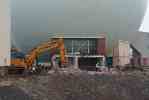 D1112, a former workshop and part
of the DFR complex, was recently demolished. Tucked into the bottom half
of the world famous sphere, and built with steel and brick, it has one
interesting feature, according to project supervisor, Donald Macaskill “It
was butted directly on to the sphere, with one of its gables formed from
the outer steel casing. A steel flashing, welded to this casing, made the
building watertight.” A number of contractors were
involved in the whole operation and included the removal of nitrogen
pipework and the removal of NaK wetted pipework. Final demolition was
carried out by John Gunn and Son, Lybster. D1112, a former workshop and part
of the DFR complex, was recently demolished. Tucked into the bottom half
of the world famous sphere, and built with steel and brick, it has one
interesting feature, according to project supervisor, Donald Macaskill “It
was butted directly on to the sphere, with one of its gables formed from
the outer steel casing. A steel flashing, welded to this casing, made the
building watertight.” A number of contractors were
involved in the whole operation and included the removal of nitrogen
pipework and the removal of NaK wetted pipework. Final demolition was
carried out by John Gunn and Son, Lybster.
UKAEA Student Takes Best Building Student
Award
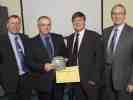 Mark
Aitken, UKAEA reactor decommissioning, was recently awarded the 'Robert
English' award for the best student on the Chartered Institute of
Building, Direct Membership Course 2004, at Inverness College UHI. This is
the second year in succession a member of reactor decommissioning has
lifted this award. In 2003, the winner was Ken Tyrrell. Mark
Aitken, UKAEA reactor decommissioning, was recently awarded the 'Robert
English' award for the best student on the Chartered Institute of
Building, Direct Membership Course 2004, at Inverness College UHI. This is
the second year in succession a member of reactor decommissioning has
lifted this award. In 2003, the winner was Ken Tyrrell.
Dounreay Takes A Look At Multiple
Sclerosis
Recently, Linda Olverman, an M.S. specialist nurse, visited site, and gave
a presentation titled, Overview of Multiple Sclerosis and Implications for
the Workplace. So what is this degenerating disease, how does it
affect people, and how do they cope? Ian Baddeley a MS
sufferer who works at the Dounreay site describes how he copes whilst
continuing to work.
17 June 04
UKAEA Police
Now In New Building
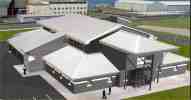 Officers
and staff of UKAEA Constabulary (UKAEAC), recently moved into a new police
headquarters on site, officially titled the Police Command Control
Building, having previously operated from a number of centres. The
centralising of their functions makes sense to Chief Inspector Martin
O’Kane: “Whilst I would claim the unit was a very efficient one in the
past, the bringing together of all staff and all the operational
requirements under one roof, greatly adds to that efficiency and good
management.” Officers
and staff of UKAEA Constabulary (UKAEAC), recently moved into a new police
headquarters on site, officially titled the Police Command Control
Building, having previously operated from a number of centres. The
centralising of their functions makes sense to Chief Inspector Martin
O’Kane: “Whilst I would claim the unit was a very efficient one in the
past, the bringing together of all staff and all the operational
requirements under one roof, greatly adds to that efficiency and good
management.”
DOUNREAY’S 1000th APPRENTICE TELLS FIRST MINISTER OF INTERNATIONAL
VISION
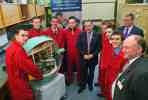 UKAEA’s
1000th engineering apprentice at Dounreay was introduced to First Minister
Jack McConnell today and told him: “The skills I’m learning can become
Scotland’s newest export to the world.” Gary Davidson (18) from Wick
was speaking at the annual UKAEA apprentice-giving ceremony at the
Pentland Hotel, Thurso, where the First Minister was the guest of honour.
He visited Dounreay afterwards to see Scotland’s largest nuclear
decommissioning project. UKAEA’s
1000th engineering apprentice at Dounreay was introduced to First Minister
Jack McConnell today and told him: “The skills I’m learning can become
Scotland’s newest export to the world.” Gary Davidson (18) from Wick
was speaking at the annual UKAEA apprentice-giving ceremony at the
Pentland Hotel, Thurso, where the First Minister was the guest of honour.
He visited Dounreay afterwards to see Scotland’s largest nuclear
decommissioning project.
25 October 04
TRAIL-BLAZER
- Looking Back To The first Apprentice At Dounreay
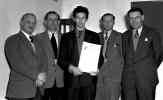 This year marks an important milestone in the history of UKAEA craft
apprenticeship scheme at Dounreay; it appoints its 1000th apprentice. The
identity of this person will be revealed at the annual apprenticeship and
trainee certificate presentation awards, to be held insert as appropriate.
This person will carry that honour as a badge of pride, and a symbol of a
scheme, started in 1955, that gave young people from Caithness and
Sutherland, and eventually from further afield, a first-class training in
their chosen engineering career. Ten of the first eleven entrants were
from Caithness, with Jim Macdonald from Sutherland, completing the number. This year marks an important milestone in the history of UKAEA craft
apprenticeship scheme at Dounreay; it appoints its 1000th apprentice. The
identity of this person will be revealed at the annual apprenticeship and
trainee certificate presentation awards, to be held insert as appropriate.
This person will carry that honour as a badge of pride, and a symbol of a
scheme, started in 1955, that gave young people from Caithness and
Sutherland, and eventually from further afield, a first-class training in
their chosen engineering career. Ten of the first eleven entrants were
from Caithness, with Jim Macdonald from Sutherland, completing the number.
18 October 04
UKAEA Awards £3 Million Reactor Clean-up Contract
The UK Atomic Energy Authority has awarded a contract to ALSTEC Ltd for
the construction of a new plant to clean up radioactive effluent that will
arise during the next phase of decommissioning the Prototype Fast Reactor
at Dounreay. The effluent will be produced during cleaning of components
and facilities that are coated with sodium liquid metal which was used as
a reactor coolant. Already more than 500 of the 1500 tonnes of this metal
has been destroyed in a £17 million plant built on site. The subsequent
cleaning of residual sodium from components will generate effluent
containing radioactive caesium-137 and cobalt-60 and this must be cleaned
up before it can be discharged safely to sea. The contract is valued in
the region of £3 million.
15 October 04
PUBLIC PARTICIPATION IN OPTIONS
FOR FAST REACTOR LIQUID WASTE
UKAEA is inviting members of the public to participate in the choice
of the Best Practicable Environmental Option for conditioning liquid
wastes that are a legacy of reprocessing fast reactor fuel at Dounreay.
Fuel irradiated in the UK’s Prototype Fast Reactor was reprocessed at
Dounreay until 1996 to separate the waste, or fission products, from the
re-usable plutonium and uranium. The waste was extracted in the form of an
acidic liquor, or raffinate, and approximately 200 m3 is stored
safely and securely on the site today.
11 October 04
DOUNREAY CLEAN-UP TIMESCALE AND COSTS REDUCED
UKAEA today announced substantial reductions in the forecast timescale
and cost of decommissioning its former experimental reactor establishment
at Dounreay. Completion of the programme has been accelerated to
2036 and the undiscounted cost reduced from £3.695 billion to £2.695
billion. Across the UK, the UKAEA today is announcing it has cut the
estimated cost of the clean-up of all its nuclear sites by almost a third.
The revised forecasts are contained in long-range plans submitted to the
Government and regulators in preparation for the launch next April of the
Nuclear Decommissioning Authority.
9 October 04
UKAEA
ANNOUNCES
£16 MILLION CONTRACT FOR SHAFT ISOLATION
Hydraulic isolation of the waste shaft at Dounreay is to be carried
out by Scottish-based Ritchies, the specialist geotechnical division of
Edmund Nuttall Ltd. Ritchies will insert a 10m-wide curtain of grout
in the rock around the shaft to stop groundwater flowing into the column
of waste. This will involve drilling between 350 and 400 boreholes in an
oval-shaped ring around the shaft and injecting grout into the fissures in
the rock.
5 October 04
SCOTLAND’S FIRST NUCLEAR REACTOR
IS OPENED TO VIEW
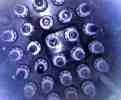
 Decommissioning engineers have looked inside
Scotland’s first nuclear reactor for the first time since it was built
almost half a century ago. A remotely-operated video camera
and radiation measurement probe was inserted inside the Dounreay Materials
Test Reactor to explore its condition. Decommissioning engineers have looked inside
Scotland’s first nuclear reactor for the first time since it was built
almost half a century ago. A remotely-operated video camera
and radiation measurement probe was inserted inside the Dounreay Materials
Test Reactor to explore its condition.
29 September 04
UKAEA
BRINGS FORWARD HYDRAULIC ISOLATION OF DOUNREAY WASTE SHAFT
The UK Atomic Energy Authority today announced plans to begin
decommissioning the waste shaft at Dounreay four years earlier than
previously planned. Following a period of public consultation, UKAEA
Dounreay has chosen grout as its preferred method of isolating the
65-metre deep facility from the surrounding groundwater. Subject to
regulatory approvals, a 10 metre-wide band of rock around the shaft will
be sealed by injecting grout into the fissures to form a deep containment
barrier that stops groundwater flowing into the shaft and becoming
contaminated with radioactivity.
14 September 04
Scientist's Nephew Sees Round Dounreay
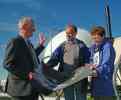 New Zealander Tony Hurst today (14 September 2004) made a nostalgic visit
to the former experimental reactor establishment where his uncle led the
world in fast reactor technology. The late Dr Robert Hurst was the first
director of Dounreay from 1958 until 1963 when the site’s landmark fast
reactor became the first in the world to supply electricity to a national
grid. His nephew, Dr Tony Hurst, is touring the UK with his wife
Margaret and decided to seek out the site of his uncle’s pioneering work. The couple called in yesterday at the visitor
centre at Dounreay that tells the story of the world-leading research
carried out there from the 1950s, and how the project is now being
dismantled. New Zealander Tony Hurst today (14 September 2004) made a nostalgic visit
to the former experimental reactor establishment where his uncle led the
world in fast reactor technology. The late Dr Robert Hurst was the first
director of Dounreay from 1958 until 1963 when the site’s landmark fast
reactor became the first in the world to supply electricity to a national
grid. His nephew, Dr Tony Hurst, is touring the UK with his wife
Margaret and decided to seek out the site of his uncle’s pioneering work. The couple called in yesterday at the visitor
centre at Dounreay that tells the story of the world-leading research
carried out there from the 1950s, and how the project is now being
dismantled.
13 September 04
Accelerated Decommissioning
Keeps The Contracts Flowing
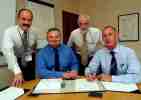 The
formal signing of the contract to build a waste-handling facility for
storing solid intermediate-level radioactive waste (ILW) at Dounreay
recently awarded to Balfour Beatty Civil Engineering Ltd by UKAEA, took
place in the board-room of Forss Business Park. The contract, valued
in excess of £10 million will increase the site's capacity for storing ILW
arising from the site's accelerated decommissioning programme. The
formal signing of the contract to build a waste-handling facility for
storing solid intermediate-level radioactive waste (ILW) at Dounreay
recently awarded to Balfour Beatty Civil Engineering Ltd by UKAEA, took
place in the board-room of Forss Business Park. The contract, valued
in excess of £10 million will increase the site's capacity for storing ILW
arising from the site's accelerated decommissioning programme.
11 August 04
PLANNING
PERMISSION
SOUGHT FOR BREEDER FUEL REMOVAL
The UK Atomic Energy Authority has applied for planning permission to
build a plant to manage the removal of the last of the breeder fuel still
inside the Dounreay Fast Reactor (DFR). Plans submitted to the
Highland Council seek consent for the construction of a facility to clean
and package the fuel after it has been removed from the landmark
experimental reactor. If permission is granted, the new facility is
expected to take two years to build and create 55 jobs during its
construction. DFR operated from 1958 until 1977. In the early
1980s, nearly all the fuel was removed from the reactor and about a third
of the uranium breeder blanket that surrounded the core was also taken
out.
6 August 04
UKAEA Board Annual Visit To Caithness
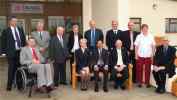 The
present board members recently made their annual visit to Caithness and
met local community members at the Park hotel. the board members
visited various parts of the Dounreay site and the Forss Business Park The
present board members recently made their annual visit to Caithness and
met local community members at the Park hotel. the board members
visited various parts of the Dounreay site and the Forss Business Park
5 August 04
CAITHNESS FIRMS WIN UPGRADE CONTRACTS
Two Caithness firms have been awarded separate contracts to improve
the infrastructure of the site, each worth in the region of £100,000.
M. M. Miller, Wick, will replace and upgrade a sewer-line in the central
area of site to meet increased demand from new buildings. It will replace
an existing line built in the late fifties. The work is due for completion
by the end of November.
John Gunn & Son, Lybster, will carry out minor upgrading and general
maintenance of the site’s five and half miles of road. This includes
changes to the roundabout at the entrance to the licensed site. The work
is to be carried out during August and September, much of it during silent
hours.
19 July 04
UKAEA CELEBRATES 50 YEARS OF FORWARD
THINKING
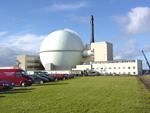 On
the 50th Anniversary of UKAEA Dipesh Shah
the Chief Executive Dipesh Shah mulls over
the achievements of the past 50 years.
Today the United Kingdom Atomic Energy
Authority celebrates its 50th Anniversary.
On 19 July 1954 UKAEA came into being
as the body responsible for taking forward
the atomic energy research programme from
the Ministry of Supply. Over the following
years UKAEA pioneered the development of an
entire industry and went on to spearhead
many other scientific and technological
advances. Today, its pioneering role
continues in its equally challenging tasks
of nuclear site restoration and leading the
UK's contribution to the international
fusion programme. On
the 50th Anniversary of UKAEA Dipesh Shah
the Chief Executive Dipesh Shah mulls over
the achievements of the past 50 years.
Today the United Kingdom Atomic Energy
Authority celebrates its 50th Anniversary.
On 19 July 1954 UKAEA came into being
as the body responsible for taking forward
the atomic energy research programme from
the Ministry of Supply. Over the following
years UKAEA pioneered the development of an
entire industry and went on to spearhead
many other scientific and technological
advances. Today, its pioneering role
continues in its equally challenging tasks
of nuclear site restoration and leading the
UK's contribution to the international
fusion programme.
30 June 04
Statement on the radioactive particles found in the local coastal
environment resulting from operations at the UKAEA site at Dounreay
The latest
statement from COMARE gives details of further recommendations on
monitoring for particles both on beaches and offshore. These
recommendations were formulated following the publication of the second
report of the Dounreay Particles Advisory Group (DPAG), the continuing
appraisal of the particles being found on the Sandside Bay beach where
public access is unrestricted and ongoing research.............The
Committee also recognises that preliminary results from the ongoing
studies to identify the health risks from the particles show that
radiation doses may be less than those originally estimated in COMARE’s
Sixth report.
15 June 04
WORK ON DECOMMISSIONING CENTRE
GETS UNDERWAY
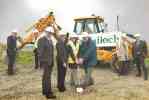 Caithness
and Sutherland Enterprise (CASE) and Highland and Islands Enterprise's (HIE)
aim of creating a decommissioning centre of excellence in the far north
reached another milestone today with the first ground works starting at
the Janetstown site. The £7 million industrial and office development is
being constructed by HIE with funding from the organisation totalling
around £3 million, with a further £2.4 million coming from the European
Regional Development Fund (ERDF). Caithness firm, JGC Engineering is
set to lease the property from HIE and CASE, which will house the Trials,
Training and Test Facility (TTTF) and the UHI Millennium Institute and
North Highland College's Decommissioning and Environmental Remediation
Centre (DERC). Caithness
and Sutherland Enterprise (CASE) and Highland and Islands Enterprise's (HIE)
aim of creating a decommissioning centre of excellence in the far north
reached another milestone today with the first ground works starting at
the Janetstown site. The £7 million industrial and office development is
being constructed by HIE with funding from the organisation totalling
around £3 million, with a further £2.4 million coming from the European
Regional Development Fund (ERDF). Caithness firm, JGC Engineering is
set to lease the property from HIE and CASE, which will house the Trials,
Training and Test Facility (TTTF) and the UHI Millennium Institute and
North Highland College's Decommissioning and Environmental Remediation
Centre (DERC).
10 June 04
UKAEA DOUNREAY CONSULTS ON CHANGE
IN REFERENCE STRATEGY FOR FAST REACTOR WASTE
UKAEA Dounreay today launches the consultation phase about its
change in reference strategy for conditioning liquid wastes that are
a legacy of reprocessing fast reactor fuel at Dounreay. A
newsletter being issued to over 800 organisations and individuals
explains the background to the issue and sets out the process for
seeking their views. Fuel irradiated in the UK’s Prototype
Fast Reactor was reprocessed at Dounreay until 1996 to separate the
waste, or fission products, from the re-usable plutonium and uranium. The
waste was extracted in the form of an acidic liquor, or raffinate,
and approximately 200m3 accumulated in underground tanks,
where it continues to be stored safely and securely today.
7 June 04
Mount Pleasant School Visit To Dounreay Visitor
Centre
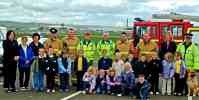 Primary 1 from Mount Pleasant Primary School visited on Monday 7 June 2004
Dounreay's Visitor Centre for their school outing. During their visit
they seen a great display from Chaz the police dog, had rides in the fire
engine and ambulance and played with the water hoses. A great time was had by all, including the adults.
The children are pictured here with staff from Dounreay's fire brigade,
ambulance service and constabulary, teaching staff and Marie Mackay from
Dounreay Communications Department. Primary 1 from Mount Pleasant Primary School visited on Monday 7 June 2004
Dounreay's Visitor Centre for their school outing. During their visit
they seen a great display from Chaz the police dog, had rides in the fire
engine and ambulance and played with the water hoses. A great time was had by all, including the adults.
The children are pictured here with staff from Dounreay's fire brigade,
ambulance service and constabulary, teaching staff and Marie Mackay from
Dounreay Communications Department.
Canisabay & Crossroads Essay Winners Visit Dounreay
 Once again this year, UKAEA
Dounreay sponsored the children’s essay competitions as part of the
Science 03 Festival held in Caithness in March. The prize-winners in
the primary section were Canisbay Primary School and Crossroads Primary
School primaries 6 and 7. Once again this year, UKAEA
Dounreay sponsored the children’s essay competitions as part of the
Science 03 Festival held in Caithness in March. The prize-winners in
the primary section were Canisbay Primary School and Crossroads Primary
School primaries 6 and 7.
Catherine Stihler - Euro
MP Visits Dounreay
Euro-MP Catherine Stihler visited Dounreay on May 11 to see the progress
being made to dismantle and clean up the former experimental reactor
establishment. Mrs Stihler toured the site with
UKAEA environmental programmes manager Mark Liddiard before visiting the
decommissioning trials and test facility at Janetstown near Thurso. There,
she was briefed by UKAEA's international collaboration manager Dr Peter
Thompson on international being forged with industry and educational
establishments in the UK and overseas. She also toured the facility with
Paul Hosking, Alstec's lead engineer for the Alkali Metal Residue Recovery
alliance at Dounreay.
Retiral News
3 May 04
UKAEA CHAIR TO STAND DOWN
Secretary of State for Trade and Industry Patricia Hewitt today
accepted the resignation of Denis Tunnicliffe CBE as Chair of UKAEA.
Mr Tunnicliffe is resigning his position in order to take up his role as a
working peer. Ms Hewitt said: "Denis has been an excellent Chair of
the UKAEA. He has been assiduous in promoting the interests of UKAEA and
its employees in the context of the creation of the Nuclear
Decommissioning Authority. Under his leadership the UKAEA has made
great strides in addressing and accelerating nuclear clean-up and I wish
him well in his new role." Mr Tunnicliffe's successor will be
announced in due course.
27 April 04
DOUBLE BOOST FOR UKAEA PENSIONS
SERVICE
UKAEA's Pensions Administration
Service, based at Thurso, Caithness, could be given the opportunity to
further develop as a public service pensions provider following the
introduction of a Government amendment to the Energy Bill now before
Parliament. The 30-strong Pensions Office has also received a boost
with the decision by the Trustee of the BNFL Group Pension Scheme to award
a five-year contract to UKAEA to carry out the administration and payroll
of the Scheme. The BNFL Group Pension Scheme covers BNFL and its
subsidiary companies and has a membership of 1600 with around 1300 active
members.
19 April 04
MINISTER SEES ENTERPRISE AT WORK
IN DOME CLEAN-UP
 Scotland's Deputy First Minister visited Dounreay on April 16th and
learned how local engineering expertise is being used to help decommission
the landmark Dounreay Fast Reactor. Jim Wallace, who is also Minister for
Enterprise and Lifelong Learning and MSP for Orkney, toured the famous
Dome of Discovery and met Alex and Pat Grant, whose company Norfrost
Technologies Ltd has manufactured a device for taking a sample of the
crust on the liquid metal coolant. Scotland's Deputy First Minister visited Dounreay on April 16th and
learned how local engineering expertise is being used to help decommission
the landmark Dounreay Fast Reactor. Jim Wallace, who is also Minister for
Enterprise and Lifelong Learning and MSP for Orkney, toured the famous
Dome of Discovery and met Alex and Pat Grant, whose company Norfrost
Technologies Ltd has manufactured a device for taking a sample of the
crust on the liquid metal coolant.
19 April 04
April Bulletin - Latest From Dounreay
19 April 04
Ex MP Robert
Maclennan Visits Dounreay
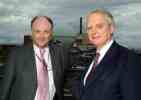 The
Rt Hon Lord Robert Maclennan visited Dounreay this week giving him the
opportunity to meet Norman Harrison, Dounreay Director. This was Robert
Maclennan's first visit to Dounreay since he stepped down from parliament
in 2001. During his visit he toured the site to see some of the changes
that have been made and had a tour of the Dounreay Cementation Plant.. He
is pictured here with Norman Harrison. The
Rt Hon Lord Robert Maclennan visited Dounreay this week giving him the
opportunity to meet Norman Harrison, Dounreay Director. This was Robert
Maclennan's first visit to Dounreay since he stepped down from parliament
in 2001. During his visit he toured the site to see some of the changes
that have been made and had a tour of the Dounreay Cementation Plant.. He
is pictured here with Norman Harrison.
2 April 04
UKAEA TO ACCELERATE DECOMMISSIONING OF DOUNREAY
 Clean-up
programme worth £313 million to be driven forward by new management team
The UK Atomic Energy Authority today announced it is accelerating
the decommissioning of the former experimental reactor
establishment at Dounreay. Site director Norman Harrison
said the timescale for complete decommissioning has been brought
forward to 2047. Clean-up
programme worth £313 million to be driven forward by new management team
The UK Atomic Energy Authority today announced it is accelerating
the decommissioning of the former experimental reactor
establishment at Dounreay. Site director Norman Harrison
said the timescale for complete decommissioning has been brought
forward to 2047.
30 March 04
MENINGITIS CASES IN DOUNREAY
On Tuesday 29 March 2004 another man
working for a sub-contractor in the Prototype Fast Reactor at Dounreay,
was admitted to hospital with probable meningitis, though the type has yet
to be confirmed. Dr Ken Oates, Consultant in Public
Health Medicine for NHS Highland said “On the basis that there is a strong
possibility that this is a further case of meningococcal meningitis it has
been decided to extend the offer of antibiotics to include all those who
work on a regular basis in the Prototype Fast Reactor. Further advice and
an update on the situation was given to all members of the workforce at
Dounreay On Wednesday 30 March.”
END OF AN ERA IN
FUEL MANUFACTURING AT DOUNREAY
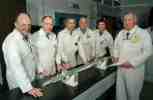 The
last batch of nuclear fuel to be manufactured at Dounreay was completed
today, signalling the end of an era in the supply of fabricated uranium
elements to research reactors around the world. Known as D1202, the
site's fuel fabrication plant was the first "active" facility to commence
operation at Dounreay in January 1957. Tomorrow, work will start to clean
out and decommission the plant. The plant manufactured some 10,000
fuel elements using a series of precision mechanical processes to turn
billets of uranium metal and aluminium into fuel elements of the highest
quality. The elements were used to fuel research reactors in Britain and
abroad that tested how different materials perform when exposed to
radiation. They also produced isotopes for industrial and medical uses. The
last batch of nuclear fuel to be manufactured at Dounreay was completed
today, signalling the end of an era in the supply of fabricated uranium
elements to research reactors around the world. Known as D1202, the
site's fuel fabrication plant was the first "active" facility to commence
operation at Dounreay in January 1957. Tomorrow, work will start to clean
out and decommission the plant. The plant manufactured some 10,000
fuel elements using a series of precision mechanical processes to turn
billets of uranium metal and aluminium into fuel elements of the highest
quality. The elements were used to fuel research reactors in Britain and
abroad that tested how different materials perform when exposed to
radiation. They also produced isotopes for industrial and medical uses.
25 February 04
PFR
Sodium Tanks Reach End Of Their Working Life
 With
the ease of a child, breaking off pieces of chocolate from a hollow easter
egg, the oxy-acetylene cutter cuts up one of the giant PFR sodium tanks
into manageable pieces. There are ten of these tanks, each with a
capacity of 143 tonnes fixed to plinths on the horizontal, within the
sodium tank-farm. With
the ease of a child, breaking off pieces of chocolate from a hollow easter
egg, the oxy-acetylene cutter cuts up one of the giant PFR sodium tanks
into manageable pieces. There are ten of these tanks, each with a
capacity of 143 tonnes fixed to plinths on the horizontal, within the
sodium tank-farm.
DECOMMISSIONING
ENTERPRISE CAN SUSTAIN
GROWTH IN RENEWABLES
Iain Todd, Director of Oil and Gas
Industry Development at the Department of Trade and Industry, visited
UKAEA Dounreay where he met senior staff to discuss how the
decommissioning skills being developed at Dounreay could be used to
support other sectors. Accompanied by Carol Gunn of the HIE
decommissioning task force, Mr Todd was keen to learn how the skills and
experience could be used to support the Government's long-term renewable
energy policies and how the skills being developed by local firms could,
in tandem with larger multi-national companies, bring additional benefits
to the area.
22
January 04
NEW TREATMENT PLANT IS
GOOD NEWS FOR THE ENVIRONMENT AND ECONOMY
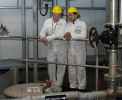 Higher
standards of environmental protection and lower levels of radioactive
emissions mean the clean-up of Dounreay is being carried out with minimal
impact on the environment. So said Dipesh Shah, chief executive of
UKAEA, when he officially opened a £7.5 million plant that is setting new
standards for the control and disposal of low-level effluent from the
decommissioning of Britain's fast reactor experiment.
The Low Level Liquid Effluent Treatment
Plant, which took three years to build, is an important part of UKAEA's
strategy to clean up effluent from the site decommissioning before
disposal. It replaces a facility dating from the 1950s that is now being
phased out of service. Higher
standards of environmental protection and lower levels of radioactive
emissions mean the clean-up of Dounreay is being carried out with minimal
impact on the environment. So said Dipesh Shah, chief executive of
UKAEA, when he officially opened a £7.5 million plant that is setting new
standards for the control and disposal of low-level effluent from the
decommissioning of Britain's fast reactor experiment.
The Low Level Liquid Effluent Treatment
Plant, which took three years to build, is an important part of UKAEA's
strategy to clean up effluent from the site decommissioning before
disposal. It replaces a facility dating from the 1950s that is now being
phased out of service.
20 January 04
ARCHIVE INVESTMENT PRESERVES DOUNREAY'S
PIONEERING HISTORY
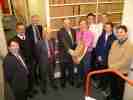 One
of the most important collections in the history of nuclear energy has
been preserved for future generations after a £400,000 investment in a new
archive facility at Dounreay.
The archive is home to some 10 million pages
of paper records contained in 21,000 boxes that would stretch for three
kilometres if laid end to end. The records chart the history of
Dounreay from its earliest construction through the pioneering days of
research and development of Britain's fast reactor experiment to the
modern-day decommissioning of the site. One
of the most important collections in the history of nuclear energy has
been preserved for future generations after a £400,000 investment in a new
archive facility at Dounreay.
The archive is home to some 10 million pages
of paper records contained in 21,000 boxes that would stretch for three
kilometres if laid end to end. The records chart the history of
Dounreay from its earliest construction through the pioneering days of
research and development of Britain's fast reactor experiment to the
modern-day decommissioning of the site.
2003 Archive
News
2002 Archive News
Dounreay Particles Advisory Group |
























